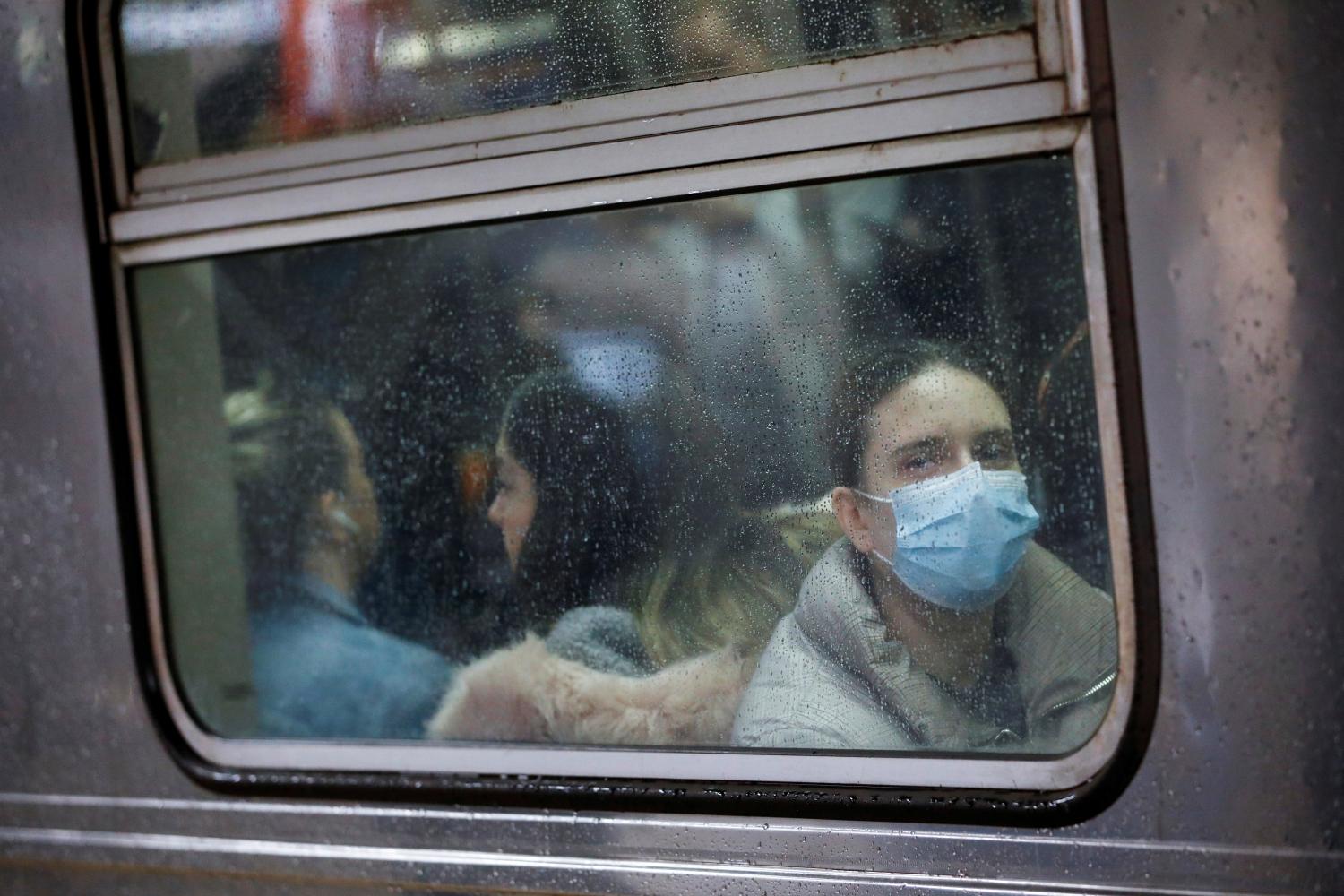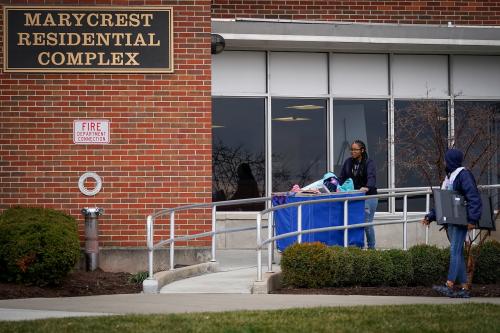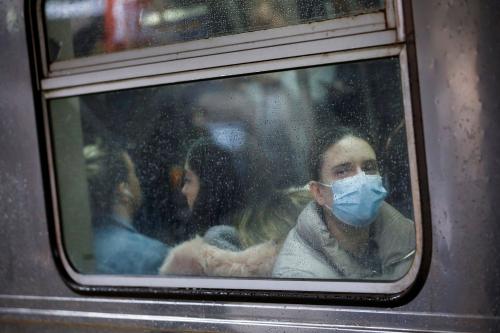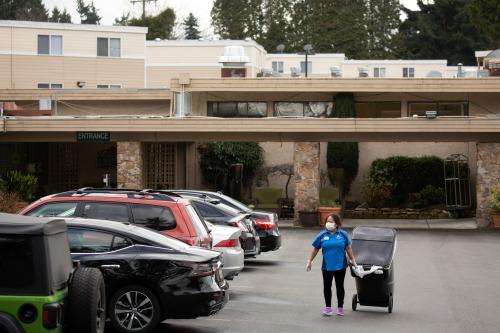As the coronavirus spreads through American communities, public health officials and the media have done a fine job educating the public about how older adults are at heightened risk from COVID-19. Nursing homes and assisted living facilities are restricting visitors and closely monitoring residents for signs of the disease. For older people with sufficient resources, the message is clear: stay home, stock up on food and supplies, and avoid group activities.
However, these recommendations fail to address the struggle of millions of low-income older adults who lack access to healthy food and adequate nutrition on a daily basis. And although social distancing is necessary to help limit the spread of the virus, anything that deters people from accessing group meals at senior centers or food banks puts low-income seniors in danger of malnutrition and hunger. Millions of them also typically cannot afford to stock up on food or supplies, and if they can, many need transportation assistance to and from grocery stores.
In light of this, federal, state, and local responders need to consider targeted solutions to ensure that food-insecure and socially isolated older adults (as well as other populations with barriers to food access) can stay fed and healthy during the crisis.
Millions of American seniors are economically insecure
The scale of economic insecurity among older adults in the U.S. often goes unnoticed. Millions have trouble affording food and spend more than 30% of their income on housing costs. As of 2015, there were more food-insecure older adults in the U.S. than there were during the Great Recession and its immediate aftermath. The table below provides statistics related to poverty, food insecurity, and housing affordability for adults age 65 and over.
| Adults age 65 and over | Data point | Source |
| Below 100% of poverty line* ($11,756 per year) | 7.2 million adults (14.1%) | Henry J. Kaiser Family Foundation, 2018. |
| Below 200% of poverty line* ($23,512 per year) | 21.4 million adults (42.0%) | |
| Food insecure |
2.9 million households (8.3% of households with an elderly individual) |
Center on Budget and Policy Priorities, 2017. |
| Spend more than 30% of income on housing | ~10 million households | Joint Center for Housing Studies of Harvard University, 2019. |
*Based on the U.S. Census Bureau’s Supplemental Poverty Measure, which adjusts for cost of living differences and other factors. Poverty thresholds are for individuals age 65 and older.
There are also significant wealth and income disparities among older adults by race, ethnicity, and gender. Black and Latino or Hispanic adults, as well as women, tend to have higher rates of economic insecurity than white adults and men. In fact, 60% of Black and Latino or Hispanic women over age 65 were 200% below the poverty line in 2017, based on the U.S. Census Bureau’s Supplemental Poverty Measure. For white women, that number was 41.4%.
Older adults experiencing poverty tend to live on fixed incomes, have limited transportation options, and often experience difficulty meeting their basic nutritional needs. This makes them especially vulnerable when an unexpected life event or financial expense occurs, because they typically do not have sufficient savings or the ability to work more to make up for losses. During a pandemic, it could be deadly.
Food insecurity heightens health risks
Older adults are more likely to have chronic health conditions such as diabetes or heart disease—a primary reason why COVID-19 is more dangerous for them. More than 84% of individuals over age 65 have at least one chronic health condition, and medical bills are the leading driver of debt in elderly-headed households. Social isolation, while beneficial for preventing the spread of the coronavirus, also tends to have negative effects on the physical and mental well-being of older adults. And even under normal conditions, older adults require special diets to maintain their general health.
The U.S. Department of Health and Human Services provides group meals in senior centers all over the country through the Older Americans Act, and many low-income older adults rely on these settings for their primary nutrition. But in response to COVID-19, many senior centers and food banks have closed. Some have stopped serving in-house meals and are switching to a to-go model. There are widespread reports of shrinking numbers of volunteers in food banks.
As part of a forthcoming study for the U.S. Department of Agriculture’s Food and Nutrition Service, I recently led a team that conducted 193 interviews with low-income adults over age 60 about their experiences obtaining food, as well as perspectives on the Supplemental Nutrition Assistance Program (SNAP, or commonly known as “food stamps”). Participants in our study reported having difficulty following their doctor’s dietary advice because they could not afford or obtain fresh produce and healthy proteins. Many participants reported having health conditions such as diabetes; if these individuals go hungry or don’t eat the right foods, they’ll frequently need medical attention. For them, the COVID-19 crisis paired with food insecurity poses an imminent health risk.
Older adults are also less likely to receive food assistance: They participate in SNAP at about half the rate of all eligible populations. There are several barriers to SNAP participation for older adults, including low awareness that they are eligible, inability to navigate the application process, low benefit levels, and a sense of shame about the need to rely on assistance programs. Even if they do apply, about 20% of households with an elderly individual received only the minimum benefit in 2018, which was (and still is) $16 per month.
Low-income older adults deserve targeted policy attention during this pandemic. The USDA has an online purchasing pilot for SNAP benefits, but during this time of crisis, the department quickly needs to make it universal. Considering the potential savings in medical costs of diverted trips to overwhelmed hospitals, Congress should consider increasing SNAP benefit levels and making grocery delivery free for SNAP-eligible individuals.
Taken together, the combination of financial, health, and food insecurity leaves low-income adults over age 65 in a very precarious position. Measures such as social distancing and restricting nursing home visits may protect the elderly from contracting the virus in the short term, but they also leave this subset of food-insecure and low-income older Americans at increased risk for malnutrition, hunger, depression, and other adverse health events. Policymakers should take additional steps to ensure these populations have consistent access to healthy food.
What can be done?
There is a wide range of short-term and long-term policies that local, state, and federal actors can consider to ease the disproportionate risks facing food-insecure older adults. Short-term solutions include:
- Shift senior center meals and food banks to a delivery model
- Prevent utilities from cutting off power, heat, or water services during the pandemic
- Launch awareness campaigns about food assistance and emergency aid programs available to older adults, including clear information about eligibility, medical deductions, and easy access to phone or video-based one-on-one assistance in the application and renewal process
- Increase funding for emergency SNAP benefits and other social safety net programs for anyone who is food insecure (the Families First Coronavirus Response Act, passed by the House of Representatives on March 14, includes this)
- Extend to all states the current USDA pilot allowing SNAP participants to purchase food online, and allow SNAP or another funding stream to cover delivery
- Increase telemedicine infrastructure, offer virtual access to health care, and publicize availability of these options to low-digital-literacy populations in order to reduce the burden on hospitals strained by COVID-19
- Offer to deliver groceries to your neighbors, family, and friends who may be facing food-insecurity issues (dropping supplies at the door to maintain social distance)
A more robust, long-term strategy would include:
- Consider ways of making grocery delivery accessible and affordable (or free), especially for populations with barriers to mobility
- Increase the minimum SNAP benefit levels
- Expand broadband access and affordability for those experiencing poverty, publicize ways that individuals can meet their basic needs through virtual tools, and offer training in digital skills
- Consider healthy frozen meal options for older adults who are otherwise unable to meet their nutritional requirements without congregate meals; such meals could be subsidized through Medicare to reduce rehospitalization and other preventable health care costs
- Streamline enrollment in multiple benefits programs through increased funding for information systems and program integration
- Expand user-friendly apps such as GetCalFresh nationwide, and hire additional staff to offer one-on-one application assistance over the phone
Advocacy organizations such as Meals on Wheels and the National Council on Aging also offer specific policy agendas for improving the food security of older adults. Taking these steps to increase access to healthy and nutritious food for seniors will not only help maintain and improve their well-being, it will literally save lives—both during the current crisis and beyond.
The Brookings Institution is committed to quality, independence, and impact.
We are supported by a diverse array of funders. In line with our values and policies, each Brookings publication represents the sole views of its author(s).








Commentary
For millions of low-income seniors, coronavirus is a food-security issue
March 16, 2020